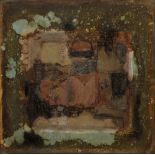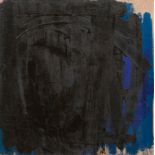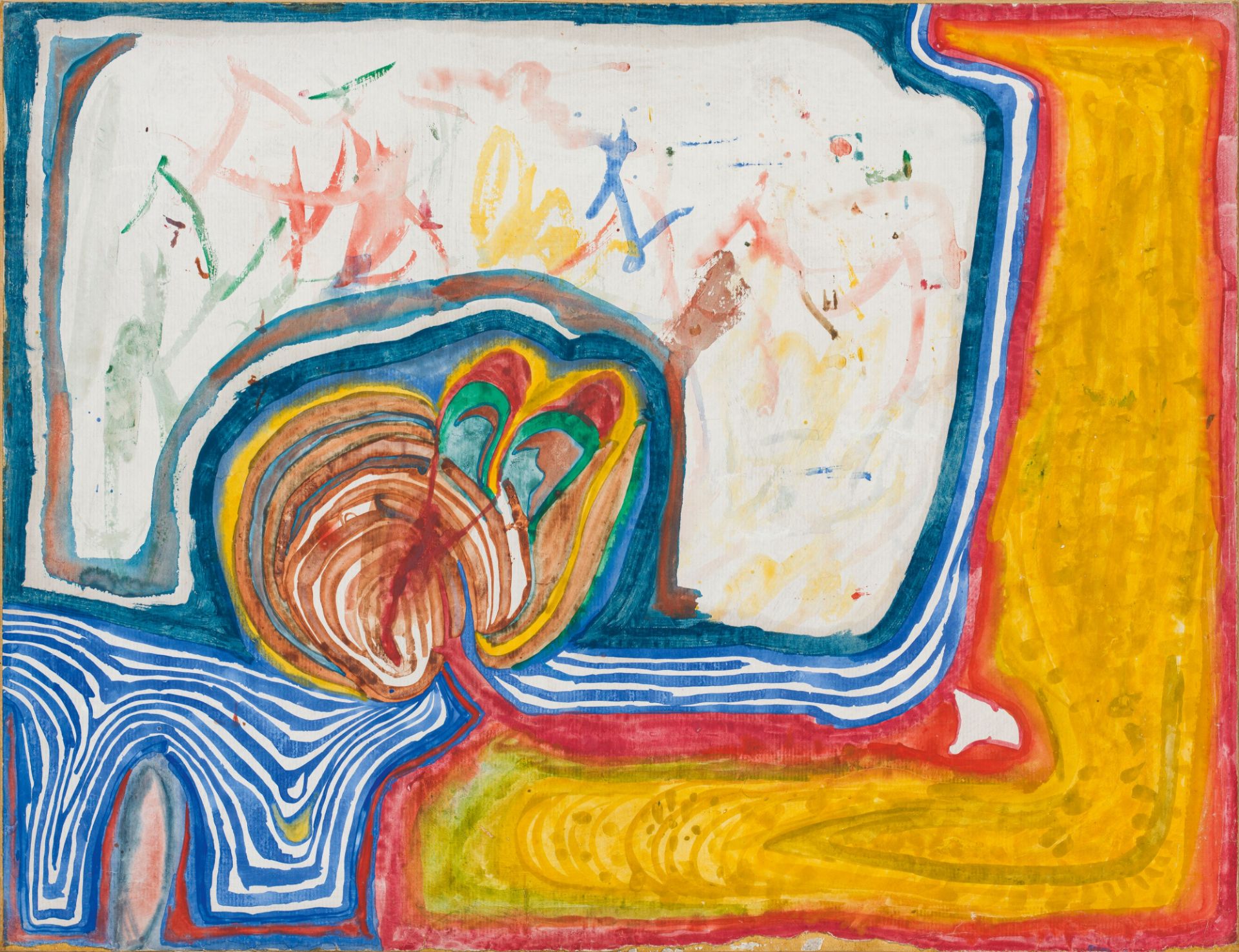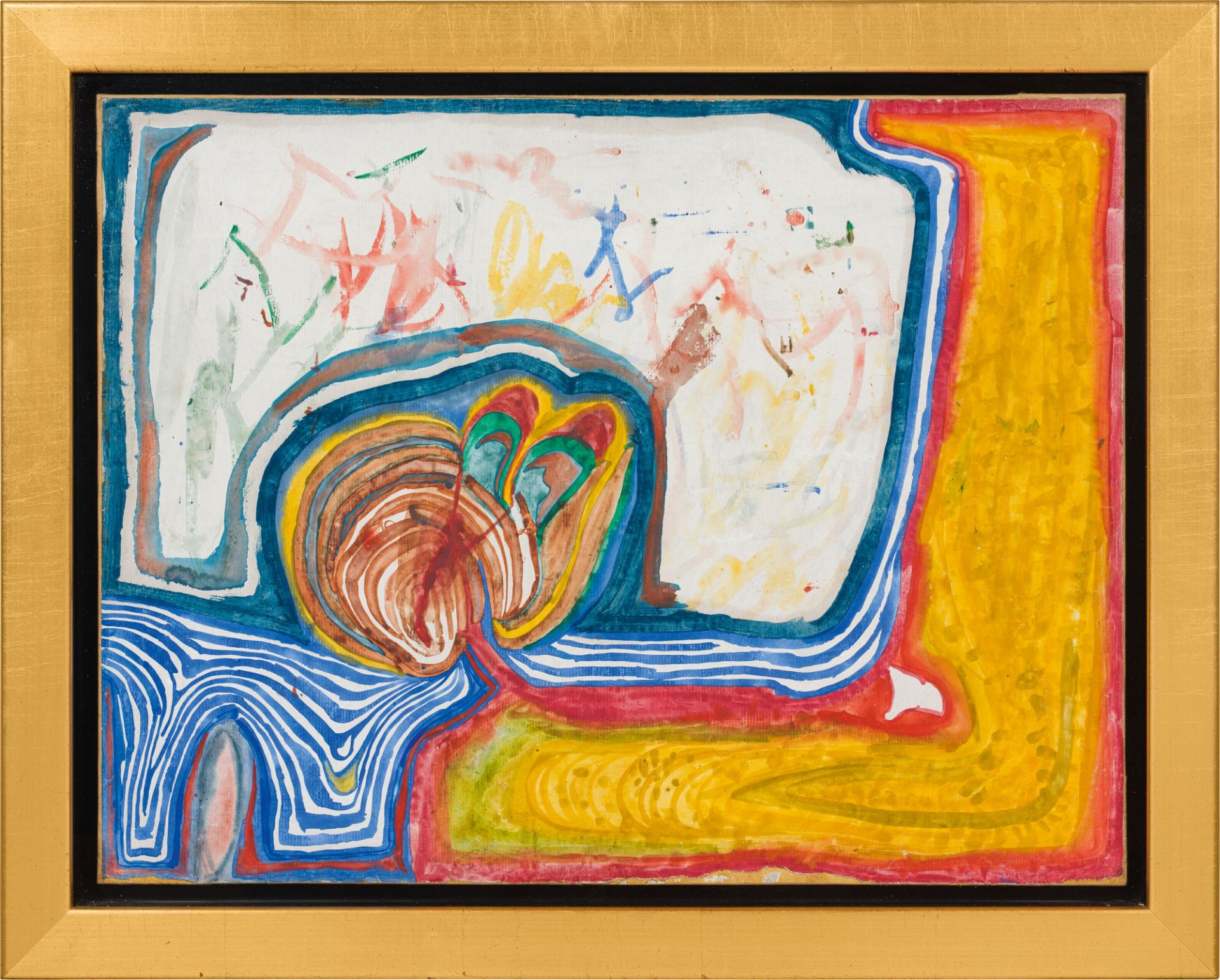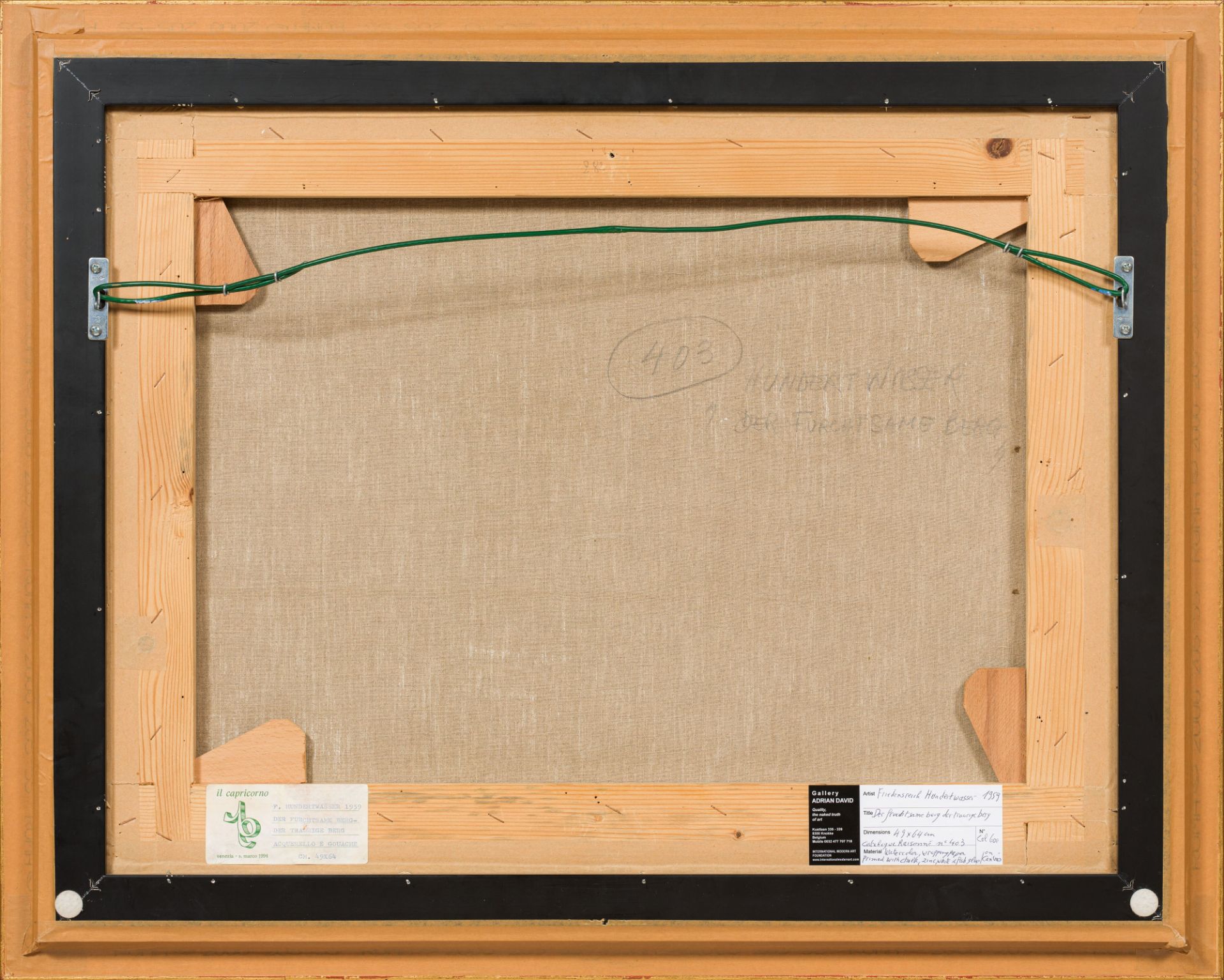28
Friedensreich HundertwasserThe Timid Mountain - The Sad Mountain1959watercolour on paper, on canvas;
Friedensreich Hundertwasser
The Timid Mountain - The Sad Mountain
1959
watercolour on paper, on canvas; framed
49 x 64 cm
signed and dated on the upper left: Hundertwasser 1959
private collection, Germany;
art collection, Belgium
Solo exhibition:
Travelling exhibition 1964/65
Kestner-Gesellschaft, Hanover, 1964
Kunsthalle Bern, 1964
Karl-Ernst-Osthaus-Museum, Hagen, 1964
Stedelijk Museum, Amsterdam, 1964
Moderna Museet, Stockholm, 1965
Museum des 20. Jahrhunderts, Vienna, 1965
Osthaus Museum Hagen, Hagen, 2015
Group exhibition:
Künstlerverein Malkasten, Düsseldorf, 1973
Art Fair, Basel, 1974
Andrea Christa Fürst, Hundertwasser 1928-2000, catalogue raisonné, Vol II., Köln 2002, ill. p. 375;
exhibition catalogue, Kestner-Gesellschaft, Hanover 1964, p. 180;
exhibition catalogue, Moderna Museet, Stockholm 1964, cat.-no. 60;
exhibition catalogue, Museum des 20. Jahrhunderts, Vienna 1965, cat.-no. 76;
exhibition catalogue, Hundertwasser Lebenslinien, Osthaus Museum, Hagen 2015, p. 29.
Friedensreich Hundertwasser's comprehensive, profound body of work makes him one of the most important Austrian artists in the history of post-war modern art. His art is unique. He painted wherever he happened to be. The period in Paris, where he stayed time and again between 1949 and 1960, was extremely inspiring for him. However, the Viennese Art Nouveau with Gustav Klimt and Egon Schiele also had a profound influence on the artist. By the end of the 1950s, he had already achieved an artistic maturity that placed him at the forefront of the international avant-garde.
This work, "Der Furchtsame Berg - Der Traurige Berg" ("The Timid Mountain – The Sad Mountain", 1959), also dates from this period. Starting in 1953, Hundertwasser focused on the pictorial motif of the spiral as a direct expression of the constantly repeating cycle of life, based on a holistic conception of art as something that connects the mind and body as well as nature and culture with one another. That symbolically charged spiral is also found in this work, positioned somewhat off-centre, in vibrant red. A streak of colour runs out from it and continues to form the outline of an orange and yellowish field, which is in turn attractively juxtaposed with the bright blue and white stripes, which come into their own are particularly in the lower left corner of the picture. In addition, the blue serves as border for the white area, which is accentuated with colourful, scattered, lightly applied brushstrokes. Hundertwasser was very fond of using bright pure colours as a significant design element. The artist’s conviction that the straight line is unhealthy for human beings, as it does not occur in nature, also finds expression in this work as a matter of course. The unique style of Hundertwasser’s art continues to hold incredible appeal.
(Sophie Höfer)
Friedensreich Hundertwasser
Der Furchtsame Berg - Der Traurige Berg
1959
Aquarell auf Packpapier, auf Leinwand; gerahmt
49 x 64 cm
Signiert und datiert links oben: Hundertwasser 1959
Privatsammlung, Deutschland;
Kunstsammlung, Belgien
Einzelausstellungen:
Travelling exhibition 1964/65:
Kestner-Gesellschaft, Hannover, 1964
Kunsthalle Bern, 1964
Karl-Ernst-Osthaus-Museum, Hagen, 1964
Stedelijk Museum, Amsterdam, 1964
Moderna Museet, Stockholm, 1965
Museum des 20. Jahrhunderts, Wien, 1965
Osthaus Museum Hagen, Hagen, 2015
Gruppenausstellungen:
Künstlerverein Malkasten, Düsseldorf, 1973
Art Fair, Basel, 1974
Andrea Christa Fürst, Hundertwasser 1928-2000. Werkverzeichnis-Catalogue Raisonné, Vol II., Köln 2002, Abb. S. 375;
Ausstellungskatalog, Kestner-Gesellschaft, Hannover 1964, S. 180;
Ausstellungskatalog, Moderna Museet, Stockholm 1964, Kat.-Nr. 60;
Ausstellungskatalog, Museum des 20. Jahrhunderts, Wien 1965, Kat.-Nr. 76;
Ausstellungskatalog, Hundertwasser Lebenslinien, Osthaus Museum, Hagen 2015, S. 29.
Friedensreich Hundertwasser zählt mit seinem umfassenden, tiefsinnigen Werk zu den bedeutendsten österreichischen Künstlern innerhalb der Kunstgeschichte der Nachkriegsmoderne. Seine Kunst ist einzigartig. Er malte, wo auch immer er gerade unterwegs war. Die Zeit in Paris, wo er sich von 1949 bis 1960 immer wieder aufhielt, war äußerst inspirierend für ihn. Aber auch der Wiener Jugendstil mit Gustav Klimt und Egon Schiele hat den Künstler tief geprägt. Bereits Ende der 1950er-Jahre erreichte er eine künstlerische Reife, sodass er sich auf der Höhe der internationalen Avantgarde bewegte.
Aus dieser Zeit, nämlich aus dem Jahr 1959, stammt auch das vorliegende Werk "Der Furchtsame Berg - Der Traurige Berg". Ausgehend von einer ganzheitlichen Kunstauffassung, die Geist und Körper sowie Natur und Kultur miteinander verknüpft, fokussierte sich Hundertwasser ab 1953 auf das Bildmotiv der Spirale als unmittelbarer Ausdruck für den sich ständig wiederholenden Kreislauf des Lebens. Diese symbolisch aufgeladene Spirale findet sich auch im vorliegenden Werk etwas aus dem Bildmittelpunkt gerückt in strahlendem Rot. Diese läuft farblich aus und bildet in der Fortführung den Umriss einer orangefarbenen bzw. gelblichen Fläche, die wiederum reizvoll den leuchtenden blauen und weißen Streifen gegenübergestellt wird, welche vor allem in der linken unteren Bildecke zur Geltung kommen. Die blaue Farbe nimmt des Weiteren ebenso die Aufgabe einer Umrisslinie für die weiße Fläche wahr, die durch locker gesetzte, vereinzelte, bunte Pinselstriche akzentuiert wird. Hundertwasser setzte sehr gerne die leuchtende reine Farbe als signifikantes Gestaltungselement ein. Auch die Überzeugung des Künstlers, dass die gerade Linie für den Menschen ungesund sei, da sie in der Natur nicht vorkomme, ist in dem Werk wie selbstverständlich umgesetzt. Mit seinem unverwechselbaren Stil übt Hundertwassers Kunst nach wie vor eine unglaubliche Anziehungskraft aus.
(Sophie Höfer)
Friedensreich Hundertwasser
The Timid Mountain - The Sad Mountain
1959
watercolour on paper, on canvas; framed
49 x 64 cm
signed and dated on the upper left: Hundertwasser 1959
private collection, Germany;
art collection, Belgium
Solo exhibition:
Travelling exhibition 1964/65
Kestner-Gesellschaft, Hanover, 1964
Kunsthalle Bern, 1964
Karl-Ernst-Osthaus-Museum, Hagen, 1964
Stedelijk Museum, Amsterdam, 1964
Moderna Museet, Stockholm, 1965
Museum des 20. Jahrhunderts, Vienna, 1965
Osthaus Museum Hagen, Hagen, 2015
Group exhibition:
Künstlerverein Malkasten, Düsseldorf, 1973
Art Fair, Basel, 1974
Andrea Christa Fürst, Hundertwasser 1928-2000, catalogue raisonné, Vol II., Köln 2002, ill. p. 375;
exhibition catalogue, Kestner-Gesellschaft, Hanover 1964, p. 180;
exhibition catalogue, Moderna Museet, Stockholm 1964, cat.-no. 60;
exhibition catalogue, Museum des 20. Jahrhunderts, Vienna 1965, cat.-no. 76;
exhibition catalogue, Hundertwasser Lebenslinien, Osthaus Museum, Hagen 2015, p. 29.
Friedensreich Hundertwasser's comprehensive, profound body of work makes him one of the most important Austrian artists in the history of post-war modern art. His art is unique. He painted wherever he happened to be. The period in Paris, where he stayed time and again between 1949 and 1960, was extremely inspiring for him. However, the Viennese Art Nouveau with Gustav Klimt and Egon Schiele also had a profound influence on the artist. By the end of the 1950s, he had already achieved an artistic maturity that placed him at the forefront of the international avant-garde.
This work, "Der Furchtsame Berg - Der Traurige Berg" ("The Timid Mountain – The Sad Mountain", 1959), also dates from this period. Starting in 1953, Hundertwasser focused on the pictorial motif of the spiral as a direct expression of the constantly repeating cycle of life, based on a holistic conception of art as something that connects the mind and body as well as nature and culture with one another. That symbolically charged spiral is also found in this work, positioned somewhat off-centre, in vibrant red. A streak of colour runs out from it and continues to form the outline of an orange and yellowish field, which is in turn attractively juxtaposed with the bright blue and white stripes, which come into their own are particularly in the lower left corner of the picture. In addition, the blue serves as border for the white area, which is accentuated with colourful, scattered, lightly applied brushstrokes. Hundertwasser was very fond of using bright pure colours as a significant design element. The artist’s conviction that the straight line is unhealthy for human beings, as it does not occur in nature, also finds expression in this work as a matter of course. The unique style of Hundertwasser’s art continues to hold incredible appeal.
(Sophie Höfer)
Friedensreich Hundertwasser
Der Furchtsame Berg - Der Traurige Berg
1959
Aquarell auf Packpapier, auf Leinwand; gerahmt
49 x 64 cm
Signiert und datiert links oben: Hundertwasser 1959
Privatsammlung, Deutschland;
Kunstsammlung, Belgien
Einzelausstellungen:
Travelling exhibition 1964/65:
Kestner-Gesellschaft, Hannover, 1964
Kunsthalle Bern, 1964
Karl-Ernst-Osthaus-Museum, Hagen, 1964
Stedelijk Museum, Amsterdam, 1964
Moderna Museet, Stockholm, 1965
Museum des 20. Jahrhunderts, Wien, 1965
Osthaus Museum Hagen, Hagen, 2015
Gruppenausstellungen:
Künstlerverein Malkasten, Düsseldorf, 1973
Art Fair, Basel, 1974
Andrea Christa Fürst, Hundertwasser 1928-2000. Werkverzeichnis-Catalogue Raisonné, Vol II., Köln 2002, Abb. S. 375;
Ausstellungskatalog, Kestner-Gesellschaft, Hannover 1964, S. 180;
Ausstellungskatalog, Moderna Museet, Stockholm 1964, Kat.-Nr. 60;
Ausstellungskatalog, Museum des 20. Jahrhunderts, Wien 1965, Kat.-Nr. 76;
Ausstellungskatalog, Hundertwasser Lebenslinien, Osthaus Museum, Hagen 2015, S. 29.
Friedensreich Hundertwasser zählt mit seinem umfassenden, tiefsinnigen Werk zu den bedeutendsten österreichischen Künstlern innerhalb der Kunstgeschichte der Nachkriegsmoderne. Seine Kunst ist einzigartig. Er malte, wo auch immer er gerade unterwegs war. Die Zeit in Paris, wo er sich von 1949 bis 1960 immer wieder aufhielt, war äußerst inspirierend für ihn. Aber auch der Wiener Jugendstil mit Gustav Klimt und Egon Schiele hat den Künstler tief geprägt. Bereits Ende der 1950er-Jahre erreichte er eine künstlerische Reife, sodass er sich auf der Höhe der internationalen Avantgarde bewegte.
Aus dieser Zeit, nämlich aus dem Jahr 1959, stammt auch das vorliegende Werk "Der Furchtsame Berg - Der Traurige Berg". Ausgehend von einer ganzheitlichen Kunstauffassung, die Geist und Körper sowie Natur und Kultur miteinander verknüpft, fokussierte sich Hundertwasser ab 1953 auf das Bildmotiv der Spirale als unmittelbarer Ausdruck für den sich ständig wiederholenden Kreislauf des Lebens. Diese symbolisch aufgeladene Spirale findet sich auch im vorliegenden Werk etwas aus dem Bildmittelpunkt gerückt in strahlendem Rot. Diese läuft farblich aus und bildet in der Fortführung den Umriss einer orangefarbenen bzw. gelblichen Fläche, die wiederum reizvoll den leuchtenden blauen und weißen Streifen gegenübergestellt wird, welche vor allem in der linken unteren Bildecke zur Geltung kommen. Die blaue Farbe nimmt des Weiteren ebenso die Aufgabe einer Umrisslinie für die weiße Fläche wahr, die durch locker gesetzte, vereinzelte, bunte Pinselstriche akzentuiert wird. Hundertwasser setzte sehr gerne die leuchtende reine Farbe als signifikantes Gestaltungselement ein. Auch die Überzeugung des Künstlers, dass die gerade Linie für den Menschen ungesund sei, da sie in der Natur nicht vorkomme, ist in dem Werk wie selbstverständlich umgesetzt. Mit seinem unverwechselbaren Stil übt Hundertwassers Kunst nach wie vor eine unglaubliche Anziehungskraft aus.
(Sophie Höfer)
Big Jubilee Auction: Evening Sale
Sale Date(s)
Venue Address
General delivery information available from the auctioneer
If you do not wish to collect your pieces from us yourself, we will arrange delivery for you. Our specialist business partners are professionals in packing, insurance and delivery and will provide these services at advantageous rates. The after-sales service usually proceeds as follows:If you would like, after the auction our logistics department will give you a quotation for transport and insurance.
If you would like to take advantage of this delivery option, contact the logistics department, after you have paid the purchase price, T +43 1 5324200-18 or r.mayr@imkinsky.com
When you place your order, your details will be sent to the appropriate shipping company. You will be contacted by our business partner to arrange a delivery date.
The price for transport and insurance is arranged directly with the shipping company.
If you don’t want to take advantage of this service, we must ask you to arrange collection yourself. We ask for your understanding that in this case we can take no responsibility for the quality of packing or transportation and can therefore take no responsibility for whether your pieces arrive intact.
Important Information
Exhibition 17-30 November
Mon-Fri 10am-6pm
Sat & Sun 10am-5pm
Terms & Conditions
Conditions of Auction
Extract from the rules of procedure
The wording of the complete rules of procedure can be viewed on our homepage www.imkinsky.com. By request we will also send the rules of procedure to you.
• Rules of Business: Auctions are conducted according to the conditions of sale as set down by Auktionshaus im Kinsky GmbH. The rules of business are available for viewing at the Auction House, and can be requested by post or email (office@imkinsky.com), they can also be called up on the internet under www.imkinsky.com.
• Estimates: In the catalogues the lower and upper estimated values are indicated and represent the approximate bid expectations of the responsible experts.
• Reserves (Limits): Sellers quite often appoint the auction house, not to sell their objects beneath certain price. These prices (= reserve/limit) usually match the lower estimate, but in special situations can also surpass them.
• Guarantee of Authenticity: The valuation, as well as technical classification and description of the art objects is carried out by the specialists of Auktionshaus im Kinsky. Auktionshaus im Kinsky guarantees the purchaser the authenticity for three years – i.e. that the authorship of the art object is as set out in the catalogue.
• Catalogue Descriptions: Catalogue information concerning techniques, signatures, materials, condition, provenance, period of origin or manufacture etc. are based on the current knowledge determined by the experts. Auktionshaus im Kinsky cannot be held responsible for the verification of these descriptions.
• Insurance: All the art objects are insured. The insurance value is the purchase price. The responsibility of the Auction House lasts until the eighth day after the auction. After that, each art object is only insured if there is an order from the purchaser to do so.
• Starting price & Hammer price: The starting price is determined by the auctioneer. The bidding rises in approximate increments of 10 % from the starting price, or from the last bid. The highest bidder acknowledged by the auctioneer will be the purchaser as long as it has reached the minimum price (reserve).
• Buyer’s Premium: For art objects which require ‘difference’ taxation the purchase price consists of the hammer price plus the sales commission of 26 %. For art objects which require ‘normal’ taxation (marked with ▲), the price consists of the hammer price plus commission of 22 %, plus VAT (13 % for paintings, 20 % for antiques). For hammer price in excess of € 300,000 we will charge a commission of 17 % (margin taxation) or 14 % (normal taxation).
• Droit de suite: Objects marked with an asterisk* in the catalogue are subject to droit de suite in addition to the purchase price. Droit de suite is calculated as a percentage of the highest bid as follows: 4 % of the first € 50,000, 3 % of the next € 150,000, 1 % of the next € 150,000, 0.5 % of the next € 150,000 and 0.25 % of the remaining amount (i.e. over € 500,000), but not exceeding a total sum of € 12,500. Droit de suite does not apply to highest bids below € 2,500.
• Absentee bids: Clients can also submit written absentee bids or bid themselves over the phone, or give an order to the broker. To do so Auktionshaus im Kinsky must have received signed order forms, (available in the catalogues), in due time.
• Telephone bids: We will do our best to establish a telephone link, but we cannot warrant for such a telephone connection.
• Online Bidding: Interested parties can participate in the auction also via the Internet. The regulations of Auktionshaus im Kinsky shall be applicable. Auktionshaus im Kinsky assumes no liability for any breakdown or loss of the Internet connection.
• Governing Law and jurisdiction: The site for the dealings between Auktionshaus im Kinsky and the purchaser is the address of Auktionshaus im Kinsky. All legal dealings or conflicts between persons involved in the auctions are governed by Austrian Law, place of jurisdiction shall be the Courts for the First District of Vienna.
Auktionsbedingungen
Auszug aus der Geschäftsordnung
Den Wortlaut der gesamten Geschäftsordnung können Sie unserer Homepage www.imkinsky.com entnehmen. Auf Wunsch senden wir Ihnen die Geschäftsordnung auch zu.
•Geschäftsordnung: Die Auktion wird nach den Bestimmungen der Geschäftsordnung der Auktionshaus im Kinsky GmbH durchgeführt. Die Geschäftsordnung liegt im Auktionshaus zur Einsicht auf, kann von jedermann per Post oder E-mail (office@imkinsky.com) angefordert werden und ist im Internet unter www.imkinsky.com abrufbar.
•Schätzpreise: Im Katalog sind untere und obere Schätzwerte angegeben. Sie stellen die Meistboterwartungen der zuständigen Experten dar.
•Mindestverkaufspreise (Limits): Oft beauftragen Verkäufer das Auktionshaus, die ihnen gehörenden Kunstwerke nicht unter bestimmten (Mindest-)Verkaufspreisen zuzuschlagen. Diese Preise (= „Limits“) entsprechen meist den in den Katalogen angegebenen unteren Schätzwerten, sie können aber fallweise auch darüber liegen.
•Echtheitsgarantie: Die Schätzung, fachliche Bestimmung und Beschreibung der Kunstobjekte erfolgt durch Experten des Auktionshauses-. Das Auktionshaus steht innerhalb von drei Jahren gegenüber dem Käufer für die Echtheit und somit dafür ein, dass ein Kunstobjekt tatsächlich von dem im Katalog genannten Künstler stammt.
•Katalogangaben: Angaben über Technik, Signatur, Material, Zustand, Provenienz, Epoche der Entstehung usw. beruhen auf aktuellen wissenschaftlichen Erkenntnissen, die die Experten ausgeforscht haben. Das Auktionshaus leistet jedoch für die Richtigkeit dieser Angaben gegenüber keine Gewähr.
•Versicherung: Die Kunstobjekte sind versichert. Versicherungswert ist der Kaufpreis. Die Haftung des Auktionshauses besteht bis zu dem auf die Auktion folgenden 8. Tag. Danach ist ein Kunstobjekt nur versichert, wenn der Käufer dies dem Auktionshaus aufgetragen hat.
•Ausrufpreis und Zuschlag: Der Ausrufpreis wird vom Auktionator festgesetzt. Gesteigert wird um ca. 10 % des Ausrufpreises bzw. vom letzten Angebot aus-gehend. Den Zuschlag erhält der Meistbietende, sofern der Mindestverkaufspreis erreicht ist. Der Käufer hat den Kaufpreis binnen 8 Tagen nach dem Zuschlag zu bezahlen.
•Kaufpreis: Bei Kunstobjekten, die der Differenzbesteuerung unterliegen, besteht der Kaufpreis aus dem Meistbot zuzüglich der Käuferprovision von 26 %. Bei Kunstobjekten, die der Normalbesteuerung (mit ▲ gekennzeichnet) unterliegen, besteht der Kaufpreis aus dem Meistbot zuzüglich der Käuferprovision von 22 % und zuzüglich der Umsatzsteuer (13 % bei Bildern, 20 % bei Antiquitäten). Bei € 300.000 übersteigenden Meistboten wird eine Käuferprovision von 17 % (Differenzbesteuerung) bzw. 14 % (Normalbesteuerung) verrechnet.
•Folgerecht: Bei Kunstobjekten, die im Katalog mit einem * gekennzeichnet sind, wird zusätzlich zum Kaufpreis die Folgerechtsabgabe verrechnet. Sie beträgt 4 % von den ersten € 50.000 des Meistbotes, 3 % von den weiteren € 150.000, 1 % von den weiteren € 150.000, 0,5 % von den weiteren € 150.000 und 0,25 % von allen weiteren, also € 500.000 übersteigenden Meistboten, jedoch insgesamt nicht mehr als € 12.500. Bei Meistboten von weniger als € 2.500 entfällt die Folgerechtsabgabe.
•Kaufaufträge: Interessenten können auch schriftliche Kaufaufträge abgeben oder telefonisch mitbieten oder den Sensal mit dem Mitbieten beauftragen. Dafür muss dem Auktionshaus zeitgerecht das unterfertigte, dem Katalog bei-liegende Kaufauftragsformular übersandt worden sein.
•Telefonische Gebote: Das Auktionshaus wird unter der ihm bekanntgegebenen Nummer eine Verbindung herzustellen trachten. Für das Zustandekommen einer Verbindung übernimmt das Auktionshaus keine Haftung.
•Online Bidding: Interessenten können an Auktionen auch über das Internet teilnehmen. Die Bestimmungen über die unmittelbare Teilnahme an Auktionsveranstaltungen gelten hierfür sinngemäß. Für das Zustandekommen einer Internetverbindung übernimmt das Auktionshaus keine Haftung.
• Gerichtsstand, Rechtswahl: Die zwischen allen an der Auktion Beteiligten bestehenden Rechtsbeziehungen unterliegen österreichischem materiellem Recht. Als Gerichtsstand wird das für den 1. Wiener Gemeindebezirk örtlich zuständige Gericht vereinbart.








